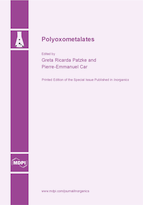Polyoxometalates
A special issue of Inorganics (ISSN 2304-6740). This special issue belongs to the section "Coordination Chemistry".
Deadline for manuscript submissions: closed (15 April 2015) | Viewed by 91809
Special Issue Editors
Interests: transition metal‐based water oxidation catalysts; photocatalytic properties of oxide‐based nanomaterials; synthesis of nanomaterials and functional hybrid composites; mechanistic studies on photocatalytic reactions; synthesis and biomedical applications of polyoxometalates
Special Issues, Collections and Topics in MDPI journals
Interests: synthesis of transition metal substituted polyoxometalates; and synthesis of lanthanide substituted polyoxometalates; molecular magnetism, magnetism; water splitting catalysis; synthesis of 3d-4f molecular materials
Special Issue Information
Dear Colleagues,
Polyoxometalates (POMs), known since the mid-18th century, have fascinated generations of researchers and continue to attract promising young scientists to date. Ever since the first pioneering investigations into the manifold structures and properties of POMs, polyoxometalate chemistry emerged as an independent and highly productive area of research, with constant and exciting new developments from an exceptionally wide range of scientific disciplines, such as synthetic/structural chemistry, biology, physics and theoretical chemistry. Indeed, polyoxometalates as highly versatile transition metal oxo-cluster materials offer virtually endless options for future applied devices. They excel through their: wide compositional and structural diversity, giving rise to flexible tuning of electronic properties, versatile redox properties, chemical stability and robustness. Among this growing family of oxo-clusters, two POM classes, namely transition metal substituted polyoxometalates (TMSPs) and lanthanide substituted polyoxometalates (LnSPs), are currently attracting special interest due to their promising role in current competitive research areas, e.g., water splitting, catalysis, magnetism, electronic materials and bio-medical applications. This Special Issue focuses on the most recent advances in polyoxometalate chemistry covering synthetic methods, mechanistic insights and application perspectives in photocatalysis (water splitting), organic catalysis, magnetism, bio-medicine, electrochemistry and other currently relevant areas.
Dr. Pierre-Emmanuel Car
Prof. Dr. Greta R. Patzke
Guest Editors
Manuscript Submission Information
Manuscripts should be submitted online at www.mdpi.com by registering and logging in to this website. Once you are registered, click here to go to the submission form. Manuscripts can be submitted until the deadline. All submissions that pass pre-check are peer-reviewed. Accepted papers will be published continuously in the journal (as soon as accepted) and will be listed together on the special issue website. Research articles, review articles as well as short communications are invited. For planned papers, a title and short abstract (about 100 words) can be sent to the Editorial Office for announcement on this website.
Submitted manuscripts should not have been published previously, nor be under consideration for publication elsewhere (except conference proceedings papers). All manuscripts are thoroughly refereed through a single-blind peer-review process. A guide for authors and other relevant information for submission of manuscripts is available on the Instructions for Authors page. Inorganics is an international peer-reviewed open access monthly journal published by MDPI.
Please visit the Instructions for Authors page before submitting a manuscript. The Article Processing Charge (APC) for publication in this open access journal is 2700 CHF (Swiss Francs). Submitted papers should be well formatted and use good English. Authors may use MDPI's English editing service prior to publication or during author revisions.
Keywords
- synthesis, characterization techniques and mechanistic studies
- photocatalysis and water splitting
- catalysis
- energy conversion and storage
- hybrids
- magnetism
- electrochemistry
- modeling and theoretical studies







